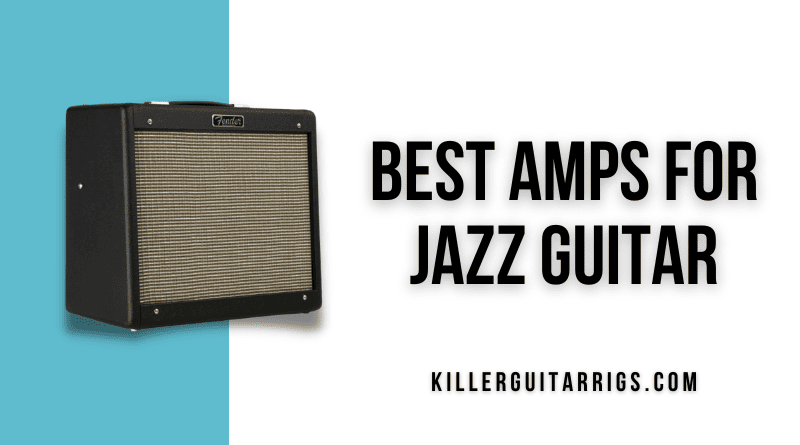The best amps for jazz offer the guitarist a great balance of tone and feel, allowing intricate lines and chords to come through as cleanly as possible.
When choosing the best jazz amplifier for you, several considerations come into play, including your personal preferences. Because there are so many models out there, it may be challenging to know which to go for. But don’t fret (pun intended), we’re here to help.
In this KillerGuitarRigs Review, we’ll be showing you a variety of the best jazz guitar amps on the market today. During the review, we focused on tone, response, build quality, and versatility. To make sure that everything was covered on a level playing field, we used the same Fender Thinline Telecaster for each test. Keep on reading to learn more.
Read more about our review process.
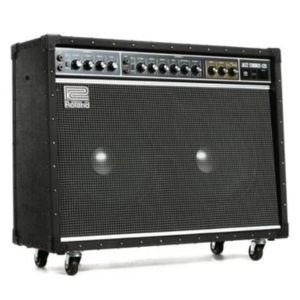
Roland JC-120 Jazz Chorus
Features: True stereo chorus, 2 60w power amps, Spring reverb
Benefits: Legendary clean tones, Amazing build quality, Superb pedal platform
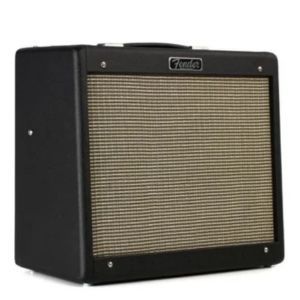
Fender Blues Jr IV
Features: 12" Celestion A-Type speaker, 15 Watts Class A power, 3 Band EQ
Benefits: Easy sound shaping, Crisp cleans, Extremely touch responsive
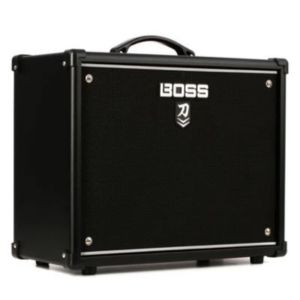
Boss Katana 50 MKII
Features: Built in attenuator, 5 Amp voicings, Up to 60 Boss FX
Benefits: Extremely versatile, Great sound quality, Practice and gig ready
Contents
Our Top 3
Our Top Pick was the Fender Blues Jr IV. With an all-tube design, fantastic response, and portability, this amp is a great choice for guitarists looking for a good Fender tone at a great price.
Musicians looking for a jazz guitar amp at a truly affordable price should check out our Best Budget option, the Boss Katana 50 MkII. This amp delivers great tone and ease of use with five amp voicings that ensure versatility. With plenty of customizable effects and features, this amp offers fantastic value.
If you’re not worried about price and quality is your main consideration, take a look at our Editor’s Choice, the Roland JC-120. Simply said, this is one of the most respected and renowned amps in history. Known for its beautiful clean tones and dense reverb and chorus effects, it comes on a powerful 2×12 configuration with an impressive 120 watts of power.
Individual Reviews

Fender Blues Jr IV
Fantastic tube tone and feel in a portable size.
The Fender Blues Jr IV is one of the most popular amplifiers in Fender's storied history of great amps. This is the fourth version of this amp and gives the user fantastic portability with great build quality and unmistakable Fender tone and feel.
The Fender Blues Jr IV is among this company’s most popular amps as it strikes an ideal balance of tone, convenience and price. Additionally, this amp also excels in ease of use, with an intuitive 3-band EQ and reverb knob. It featured a 12-inch Celestion A-Type speaker and was wrapped in durable black textured vinyl.
During our tests, we got an excellent clean jazz tone with lots of that definitive Fender chime. We played everything from jazz standards to blues tunes, as well as open chords to check for note separation and clarity, and we found the Blues Junior delivered when it came to the famed Fender headroom. It delivered plenty of volume, while avoiding breakup.
We loved the tone we got from the three 12AX7 preamp tubes especially as they paired greatly with the two EL84 power tubes. This combination gave us beautiful warmth and it became obvious why it’s such a popular tube configuration. With 15 watts of tube power on tap, we found it was suitable for gigging and recording, while remaining manageable for at-home practice.
One of our favorite features on this amp was the Fat switch. This gave us a boost through the mids and pushed the preamp stage a little more, which we think would be ideal for single-coil players trying to get closer to humbucker warmth and thickness.
We tested it with a variety of pedals and it sounded great. The cavernous headroom really allowed the character of the FX to shine, and while jazz players aren’t always looking to add a ton of effects to their signal chain, it’s nice to know this amp is versatile enough to work well across genres. We found that it took modulation and time-based effects particularly well. In terms of using our own pedals, this amp responded great, giving us everything from grit to beautiful cleans, depending on the pedal.
Verdict: The Fender Blues Jr IV provides an authentic all-tube Fender tone that works nicely in a variety of situations. We loved how it sounded at 15 watts and felt it’s an ideal amp for guitarists of all levels, offering great tone and fantastic response.

Boss Katana-50 MkII
A compact amp that excels in versatility and ease of use.
Since its release, the Boss Katana series of amps has become one of the most popular among savvy guitarists. With outstanding versatility, excellent tone, extensive features, and typical Boss intuitiveness, this amp is a great choice for beginners as well as seasoned guitarists looking for an affordable option.
The Boss Katana-50 MkII delivers great tone and ease of use with five amp voicings that ensure versatility. This amp came with plenty of customizable effects, and the ever fantastic Boss Tone Studio editor software that allowed us to dial in the exact tone we were after. With Clean, Crunch, Lead, Brown, and Acoustic amp voicings, we got a great number of tonal options.
We started our tests by running through some of the Katana-50’s 60 Boss effects. Easily accessible from the Tone Studio editor software, we found everything from powerful distortions all the way to a lush chorus, and tweaked them to our liking via the editor.
Out of the five voicings, our favorite for jazz was the clean amp voicing, which gave us a nice and open clean tone. This was perfect for chord solos and bebop phrasing. We also liked the Brown voicing for a more modern fusion situation.
This Boss amp responded nicely to our playing. Our lead tone was authoritative and penetrating, and it gave us a nice feel playing rhythm parts, whether distorted or clean.
One of our favorite aspects of this amp was how easy to use and intuitive it was. The control panel is conveniently located at the top of the unit and was divided into four sections. The first section to the left was where we selected the amp type, and also came with knobs for gain and volume.
We would then dial in our ideal EQ depending on the voicing and use, by using the three separate knobs for Bass, Middle, and Treble. The effects section, also with three knobs, gave us vast options with a Booster/Mod, FX/Delay and Reverb.
We also loved how the Katana-50 allowed us to organize our sounds by allowing us to choose between channels 1 and 2. For ultimate convenience, it also offers three wattage options: 0.5W, 25W, and 50W. This allowed us to go from very loud to very quiet without affecting the tonal quality, ideal both for the stage and late-night practice situations.
Verdict: The Boss Katana-50 MkII offers great flexibility and ease of use in a combo amp. With five amp voicings, a vast variety of effects, and different wattage options, it’s a great choice for any beginner looking to start out the right way. To learn more, check out our full review.

Roland Jazz Chorus JC120
One of the most iconic amps in history.
The Roland JC-120 is nothing short of a legend and for good reason. For decades, this amp has been used by countless stars and guitar heroes. It is beloved for its glorious clean tone and its ability to take pedals remarkably well, and makes a great choice for serious players and professionals looking for the very best jazz amp around.
The Roland JC-120 is one of the most respected and renowned amps in history, known especially for its gorgeous clean tones and lush reverb and chorus effects. With a 2×12 configuration and an impressive 120 watts of power, this amp is also revered for being loud.
Right from the first chord we strummed, we got that pristine clean tone that the Jazz Chorus is known for. It was super responsive and we loved everything about it, from open chords to well chord inversions on jazz standards.
Besides delivering outstanding clean sounds, the JC-120 pairs really well with pedals. Everything from fusion solos on the edge of breakup to jazz-funk sounded fantastic on this amp, as it allowed the true character of our pedals to come through.
The JC-120 also reacted nicely to our delay and modulation pedals. Naturally, the reverb and chorus effects on this amp are also legendary and we loved combining these with some of our more experimental fuzz pedals.
Verdict: The Roland JC-120 Jazz Chorus is a great choice for serious players who want one of the best-known clean-tone amps in history. With the ability to take pedals remarkably well, this pedal delivers great response, feel, and sound, and continues to be one of the most popular amps on the market half a century after its release.
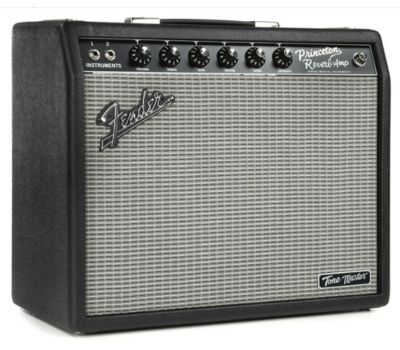
Fender Tone Master Princeton Reverb
A solid-state combo amp with modeling technology.
The Princeton Reverb comes from a storied lineage that is among Fender's most cherished amps. This particular model comes with 12 watts and a solid-state design that relies on modeling technology to reproduce the warmth and responsiveness that the Princeton series is known for.
The Fender Tone Master Princeton Reverb is Fender’s attempt to create a solid-state version of the renowned Princeton Reverb amp. With a single 10” Jensen C10R ceramic speaker and weighing in at 19.9 lb, this amp is a good choice for working guitarists who want great tone at their gigs without carrying around a heavy load.
During our tests, the Fender Tone Master Princeton Reverb gave us excellent cleans with ample headroom that made our chords and lead lines shine. We liked how it sounded on several applications, from a modern Wayne Krantz single-coil bridge pickup, all the way to darker jazz tones with our neck pickup and the tone dialed down.
In our tests, this amp paired nicely with many of our distortion pedals, making it a good choice for fusion, blues, and even experimental jazz gigs. Our modulation, delay, and reverb pedals also sounded good through this amp, making it that much more versatile.
One of our favorite features on this amp was the 5-way attenuator switch located on the back panel. It allowed us to change the power and select among 12, 6, 3, 1.5, 0.75, and 0.3 watts. We thought this was a great trait to have on an amp, as it allowed us to pick the best setting for different uses, including bigger venues for gigging, smaller venues, all the way to very quiet practice sessions and bedroom use.
Other useful features on this amp included reverb, speed, and intensity knobs for dialing in tremolo, a 2-button footswitch to switch between reverb and tremolo, two models of speaker emulation, and a balanced XLR output.
This solid-state version of the famous Princeton Reverb both weighed and cost significantly less than the tube version. Although it comes pretty close, it didn’t have quite the same organic tone and “magic” of the original Princeton.
Verdict: The Fender Tone Master Princeton Reverb delivers good tone and convenience by relying on digital technology to recreate the traditional Princeton Reverb. With 12 watts of power and a five-way power attenuator, this amp is a good choice for everything from practicing to playing live gigs with good quality and convenience, at a lower cost.
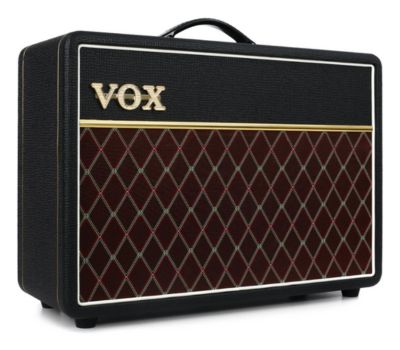
Vox AC10C1
Simplicity and ease of use with authentic British tone.
Vox is among the top names in guitar amplification, the AC line of amps helped establish the paradigm of what British tone is. The AC10C1 brings that same ethos and attitude in a straightforward amp that delivers that same quality tone but with a much smaller footprint.
The Vox AC10C1 comes in a convenient 1×10″ configuration and offers authentic British tube tone in a simple and well-built combo amp. With the tried and true combination of 12AX7 tubes for the preamp section and EL84 for the power stage, you get a piece of history in a much smaller package with this amp.
We plugged in and got a punchy clean tone, with the entire frequency range nicely represented. We liked how the Celestion VX10 custom speaker sounded along with the 12AX7 and EL84 tubes, and we got sharp response from each of our two single-coil pickups.
Next, we tried the Top-Boost on this amp by turning the gain high. Here we got some classic British tone with the unmistakable Vox shimmer, which we found to be warm and with superb touch responsiveness – great for an Allan Holdsworth type of feel. The bridge pickup sounded particularly good in this setting, with a forward attitude that was great for fusion solos.
We also liked how this amp took pedals. The AC10C1 performed well with our distortion and time-based stompboxes and allowed us to get good tones for everything from modern Bebop to smooth jazz. Although this amp does sound good, we did wish he had a few more control options to get our desired tone.
Verdict: The Vox AC10C1 is a good option for folks who gravitate toward an all-tube British tone, but want a smaller model. It comes in a practical 1×10″ configuration and delivers great response thanks to its tube design and Celestion speaker.
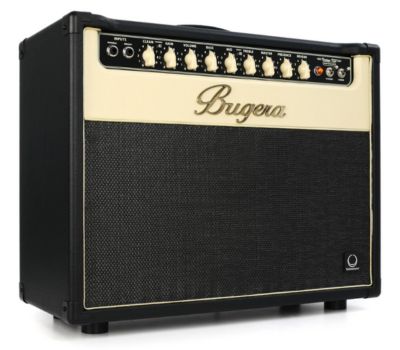
Bugera V22 Infinium
Vintage tones in an all-tube design.
This combo amplifier gives you an all-tube design that delivers that vintage tone and feel, at an affordable price. Packed with useful features and with a comfortable 1x12" configuration, this Bugera amp is a good choice for guitarists looking for a blend of good tone and fair price.
The Bugera V22 Infinium is a 22-watt guitar combo amplifier that features boutique flavor in feel and looks but not in price. It comes with the beloved tube combination of three 12AX7 preamp tubes and two EL84 power tubes.
We started our tests clean and got some classic tube warmth with a surprising amount of headroom. This amp responded nicely to our playing dynamics and everything from chord soloing to extended jazz voicings sounded great on the V22 Infinium.
We loved how responsive and simple the 3-band EQ on this amp was. With the addition of a presence knob, we were able to intuitively dial in our desired tones for both clean and distorted sounds. We loved that this amp came not only with two channels (clean and distorted) but also with normal and bright inputs, making it great for those of us who have different types of guitars.
With the gain turned up a bit, we got some chunky overdrive, ideal for jazz fusion solos and even lighter rock. When pushed further, this Bugera amp saturated nicely, serving up a John Scofield type tone. This was in part thanks to the EL84 tubes which, as expected, delivered fantastic grit when pushed.
This amp also came with Bugera’s Tube Life Multiplier Technology. This monitors the performance of the output tubes in order to give them a balanced load for reliable operation, so if you’ve been holding off on buying your first tube amp, this is a great option. You can keep track of this via an LED indicator next to each tube. Although we liked how this amp sounds, it did have more of a vintage voice, which may be a turnoff for those looking for a more modern or contemporary vibe.
Verdict: The Bugera V22 Infinium is a good choice for guitarists looking for a vintage voiced amp that’s affordable. It comes with the powerful and popular combination of 12AX7 preamp tubes with EL84 power tubes, which sounds great on both clean and distorted tones. Well-built and with useful features, this is a good choice for guitarists who like more of a traditional sound.
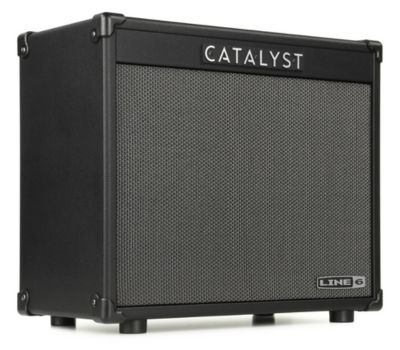
Line 6 Catalyst 60
Versatility in a multi-voiced amp.
The Line 6 Catalyst 60 amplifier is a good choice for jazz guitarists that also delve into other styles including rock and country. With six distinctive voicings, you get everything from clean open tones to powerful distortion with the turn of a knob.
The Line 6 Catalyst 60 comes in a 1×12 design and offers modeling versatility with a dedicated reverb section and 18 additional effects for tonal flexibility. With a built-in power attenuator, this amp can go from 60 watts for live gigs all the way to 0.5-watt settings or even mute for practice sessions and direct recording.
After playing around with the six original amp voicings, which cover a variety of tones from warm cleans to scorching distortion, we discovered for straight jazz playing, our favorite was the clean setting. Here we were able to dial in our preferred darker jazz tones and add a bit of reverb. Everything from Bebop to ballads sounded good and we really have to compliment the responsiveness of this amp, too.
For more modern jazz subgenres such as fusion, we preferred the boutique voicing, which gave us just enough power with good sustain for our legato lines. The Catalyst 60 is able to dial in literally hundreds of other tones that go well beyond jazz, making it a great choice for guitarists who also play other genres. Naturally, if you’re mostly interested in traditional jazz, this amp may not be your best choice, as it offers a lot of features that will likely go unused.
Verdict: The Catalyst 60 is a Solid State amp that features modeling technology in order to offer the user good quality effects. With a nice variety of voicings and other features, this amp is a good choice for guitarists who play jazz as well as other styles. An overall great choice for beginners.
How to Choose The Right Amp For You
When it comes to playing jazz guitar, finding the right amplifier is essential to achieving the warm, clean tones that define the genre. A jazz amplifier should complement your playing style, provide excellent clarity, and offer the necessary headroom for dynamic playing. Below are a few points to take into consideration.
Tone
Jazz guitarists typically seek a clean and transparent tone that allows the natural sound of the instrument to come through. Look for an amp that offers a dedicated clean channel, emphasizing clarity and articulation without excessive distortion or coloration.
Naturally, if you play modern jazz subgenres such as fusion, make sure the amp either has appropriate distortion or that it takes pedals well.
Headroom
Headroom helps you maintain clarity and dynamics at higher volumes, especially in larger venues or ensemble settings and is another important consideration for a jazz guitar amp. Higher-wattage amplifiers typically provide more headroom, allowing you to play at louder volumes while keeping the tone clean. Consider your performance needs and choose an amplifier with sufficient power to accommodate your playing style and venue requirements.
Speaker Choice
The choice of speakers significantly impacts the overall sound of your jazz guitar amplifier. Jazz tones often benefit from a balanced sound with a focus on midrange frequencies. Consider amplifier models equipped with 10-inch or 12-inch speakers, as they tend to provide the desired balance between warmth, clarity, and projection.
Versatility
You may want to play Bebop, Fusion, and even experimental jazz, so shooting for a versatile amp is a smart move. Also, take into account flexibility in tone shaping so you can get your desired jazz guitar sound. Look for an amplifier with a responsive and musical EQ section that allows you to adjust the bass, midrange, and treble frequencies.
Reverb
Reverb is a widely used effect in jazz. It adds depth and ambiance to your sound and keeps it from sounding dry and boring. Consider amplifiers with built-in reverb effects, as they provide a convenient way to achieve the desired spatial qualities in your tone.
Final Thoughts
There are plenty of capable jazz guitar amps out there. In this guide, we’ve given you seven of the best choices in the market. These run the gamut from traditional all-tube designs to convenient solid-state models with modeling technology.
To recap our best choices, Our Top Pick was the Fender Blues Jr IV. This is a tube amp that features great response and portability and is a wonderful choice for guitarists looking for a true Fender tone at a great price.
Those looking for a good jazz guitar amp at a very affordable price should check out our Best Budget option, the Boss Katana-50 MkII. This amp offers excellent tone and ease of use with five amp voicings for superior versatility. With a vast variety of customizable effects and features, this amp is a great choice.
If you’re not apprehensive about cost and quality is your major concern, take a look at our Editor’s Choice, the Roland JC-120. One of the most respected and renowned amps in history, the JC-120 is revered for its stunning clean tones and lush reverb and chorus effects.

